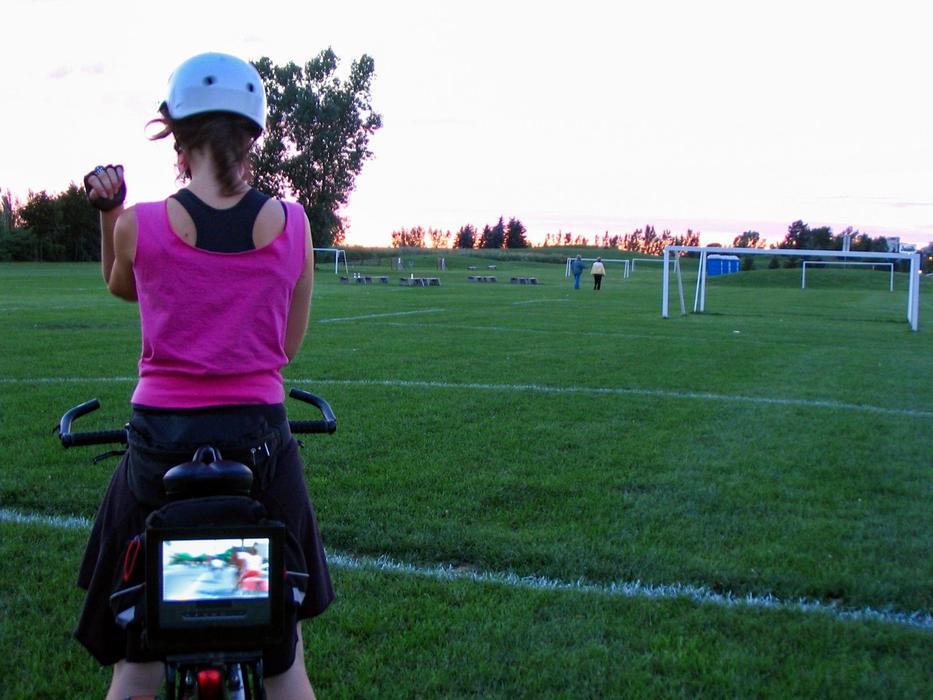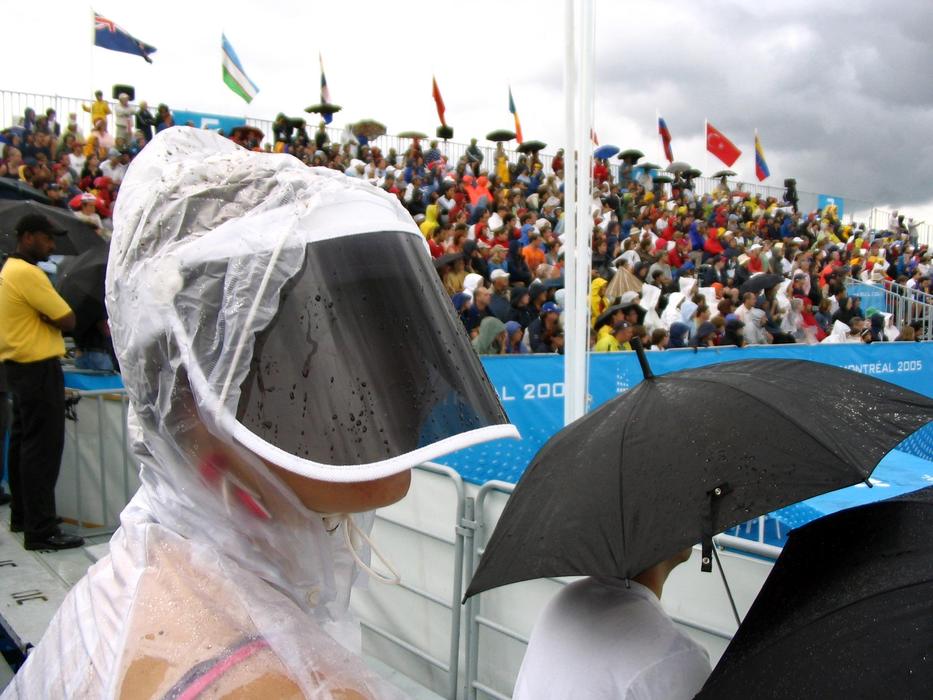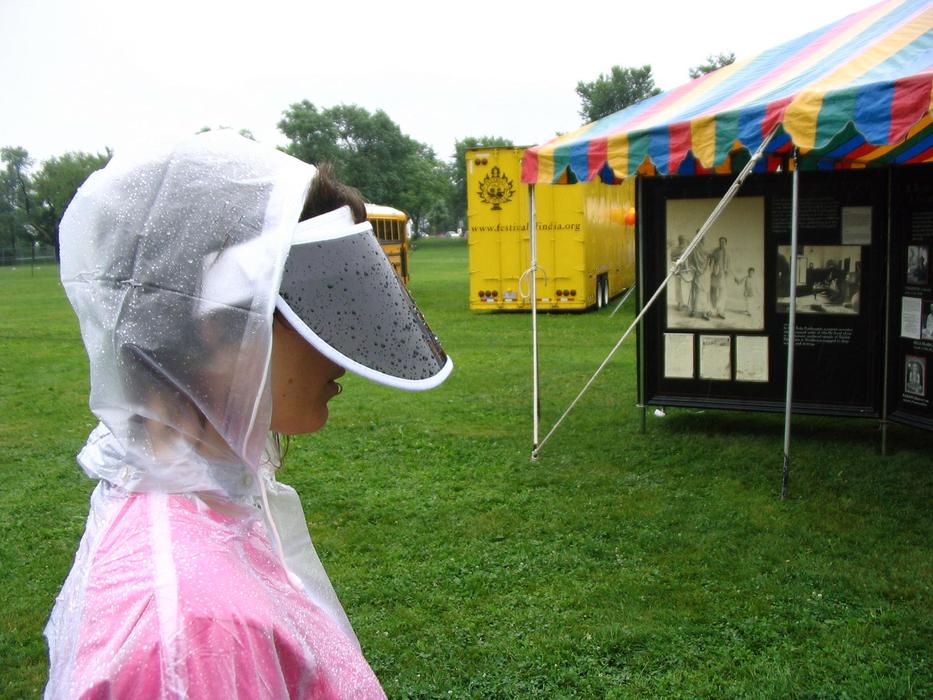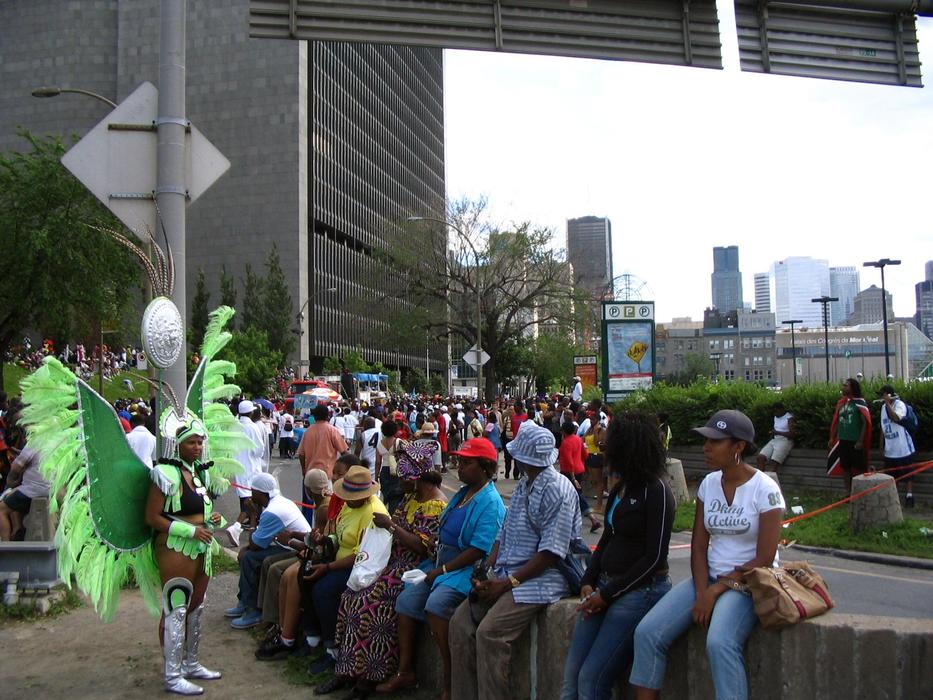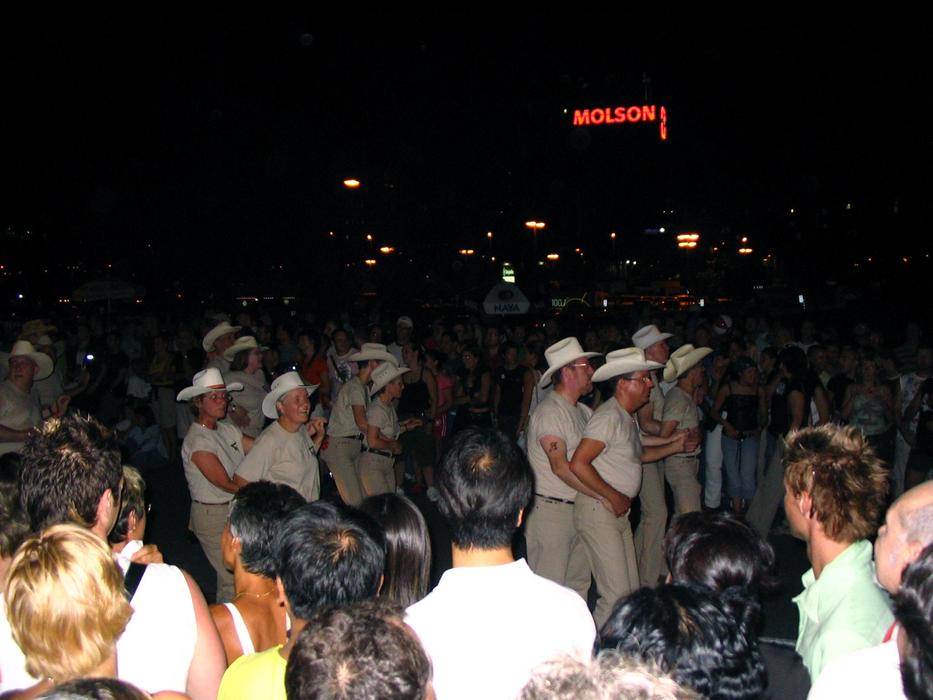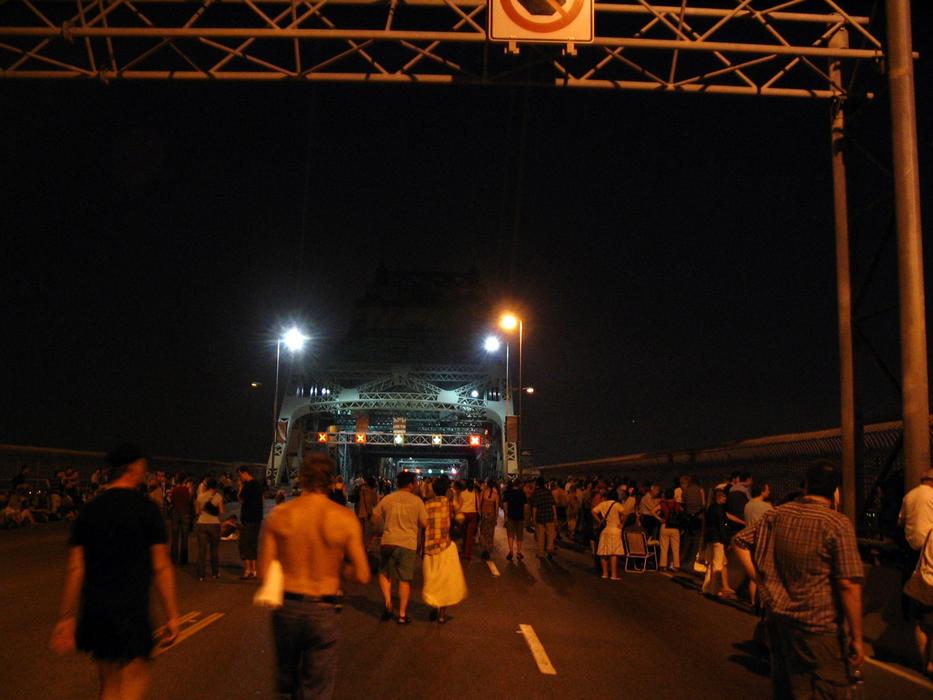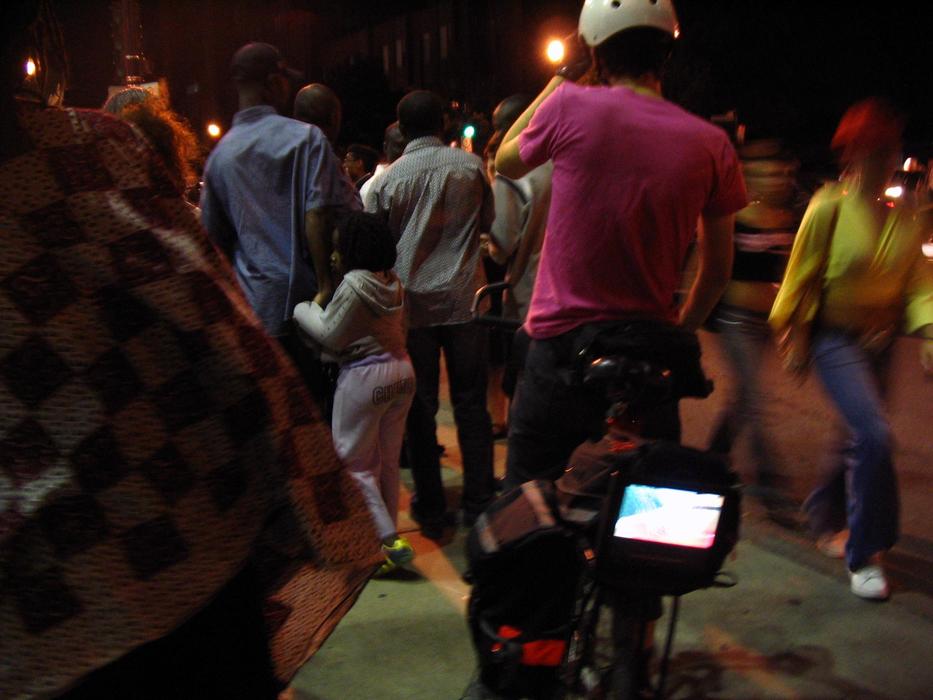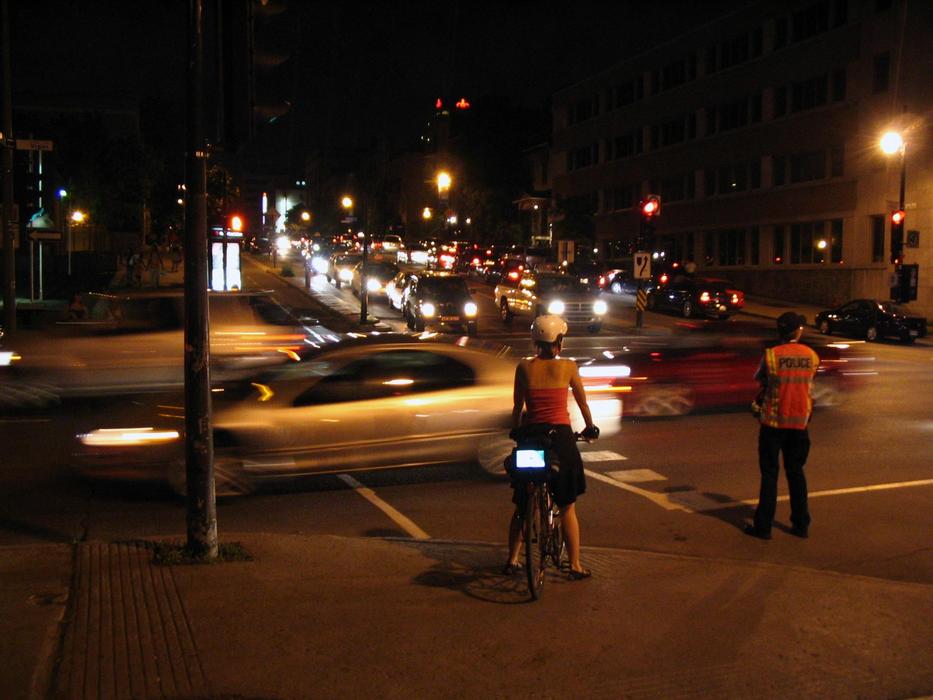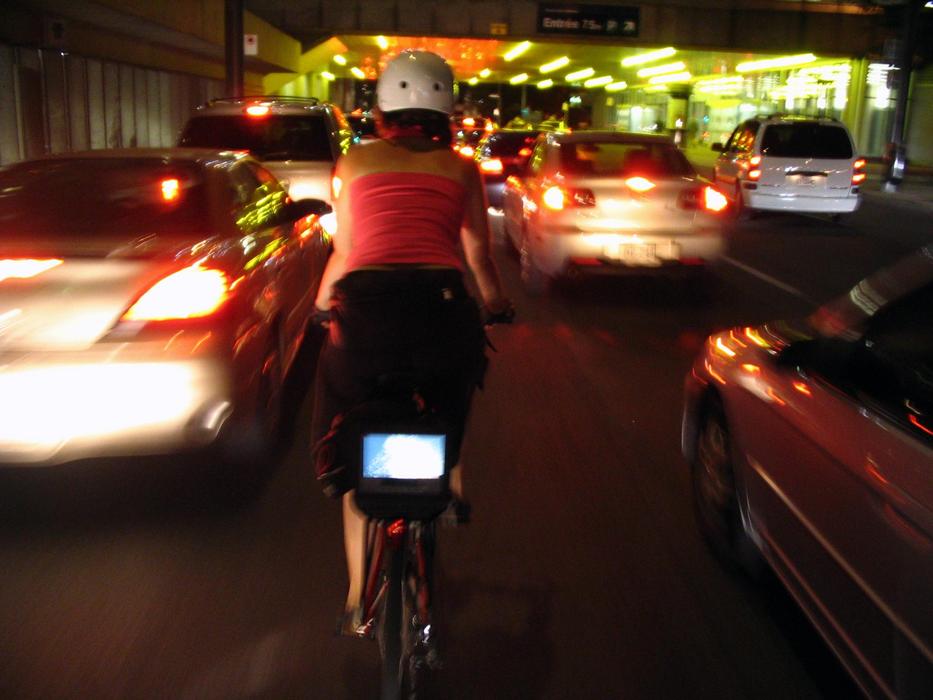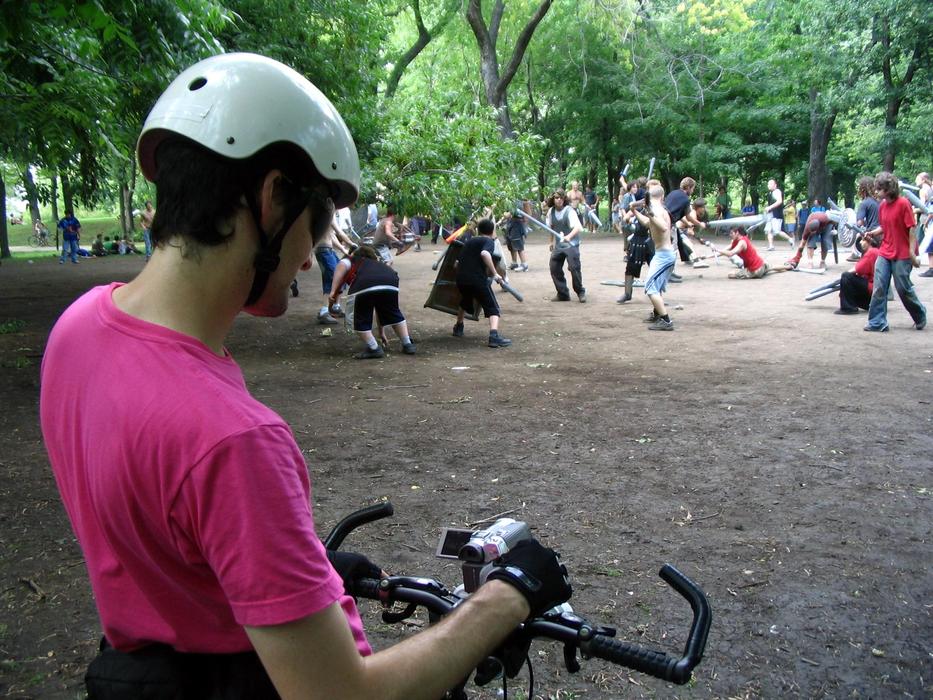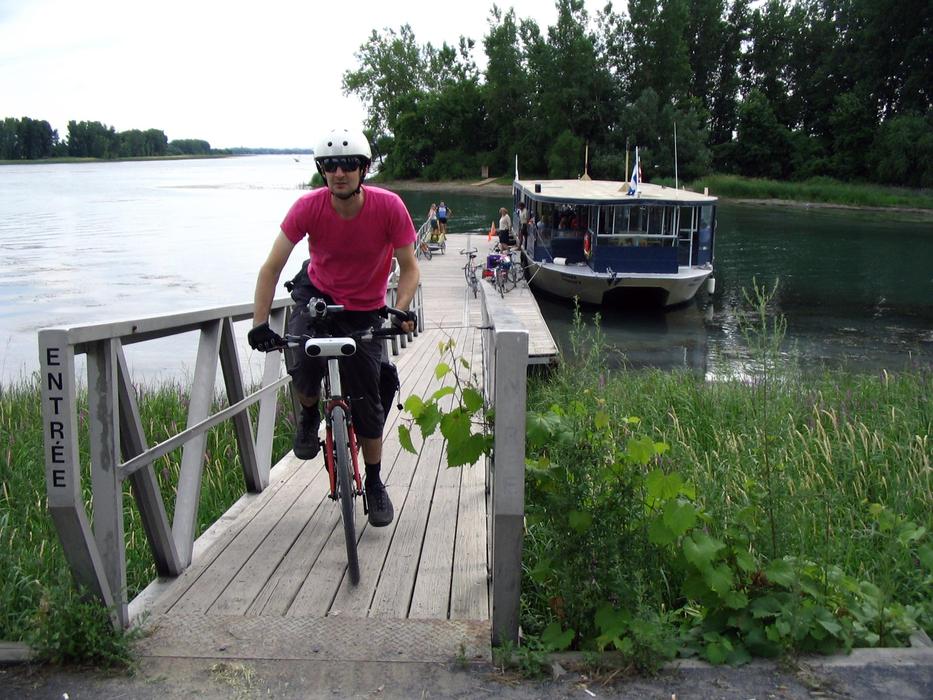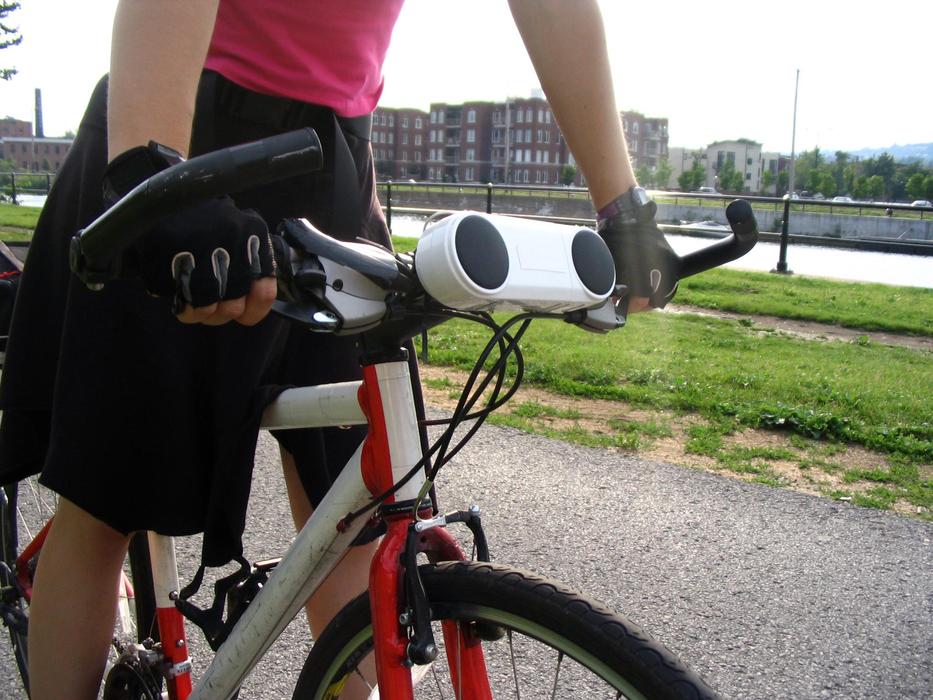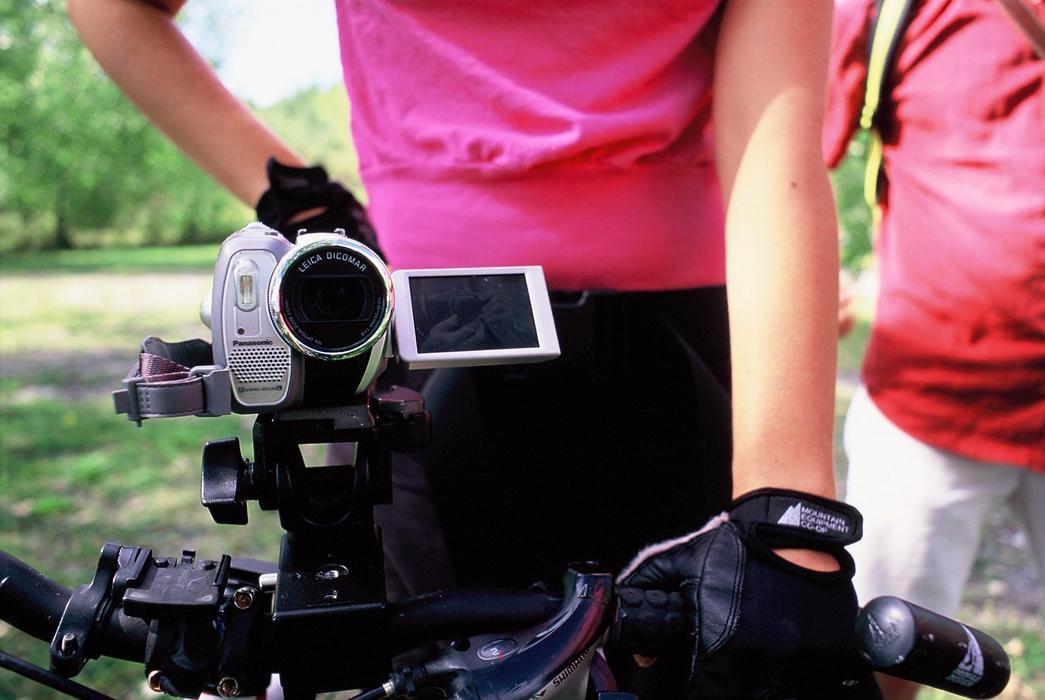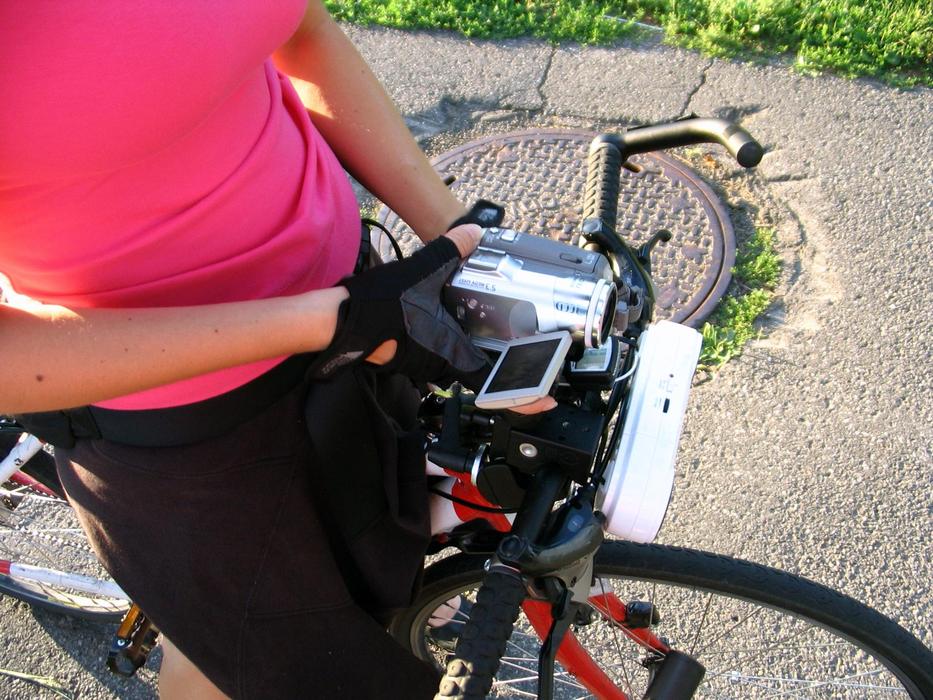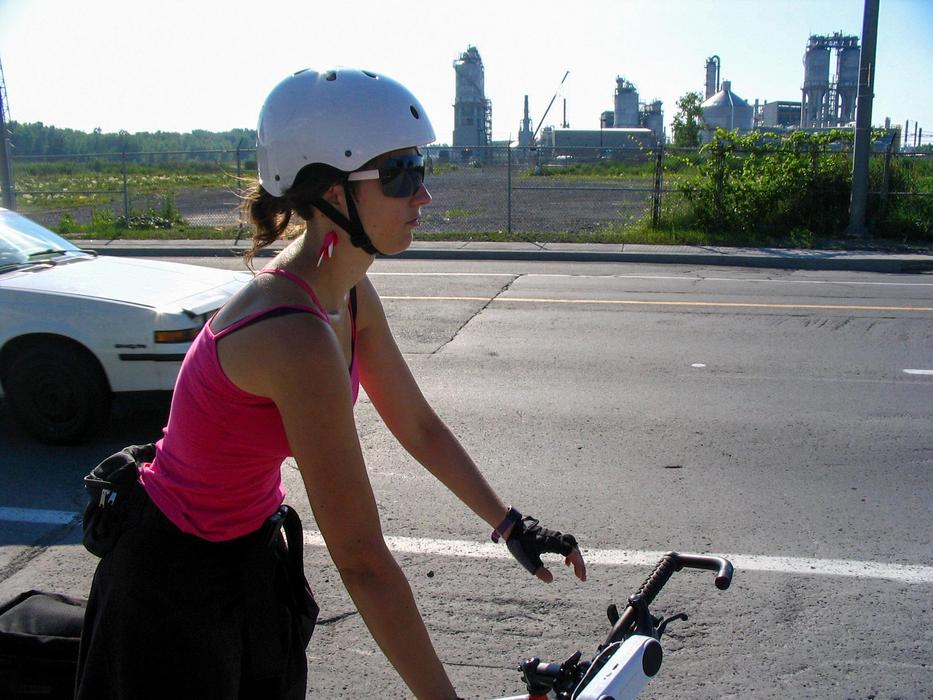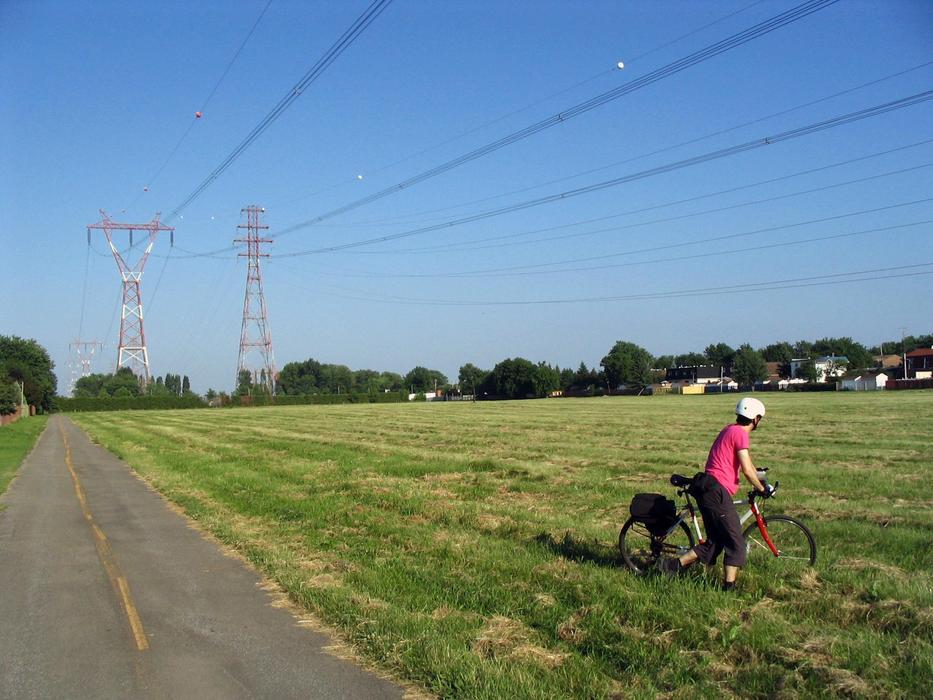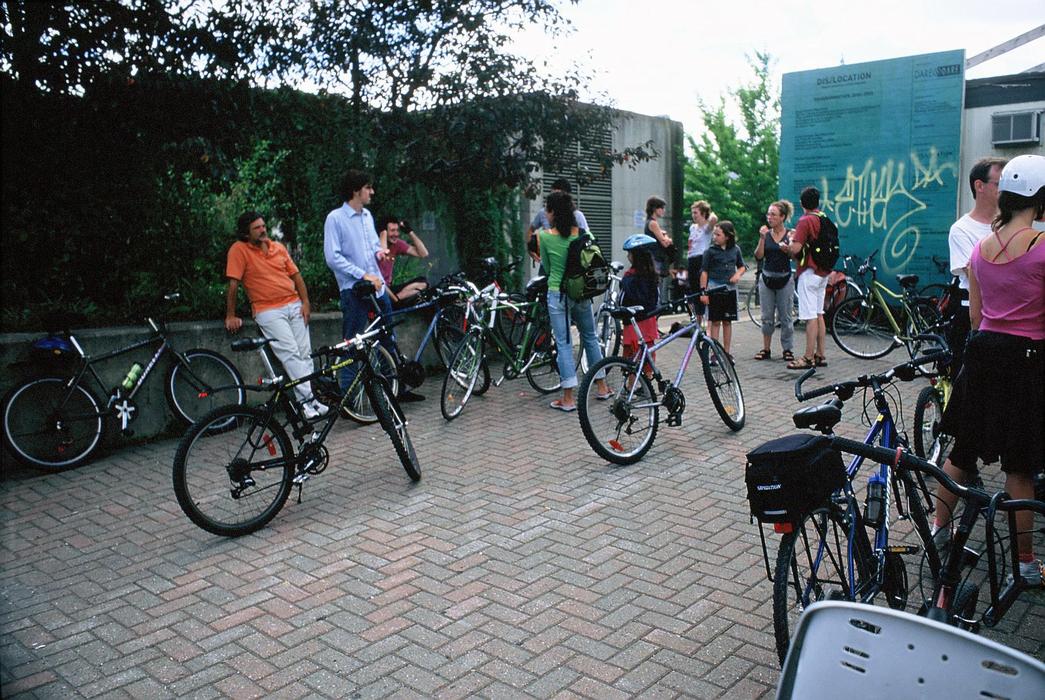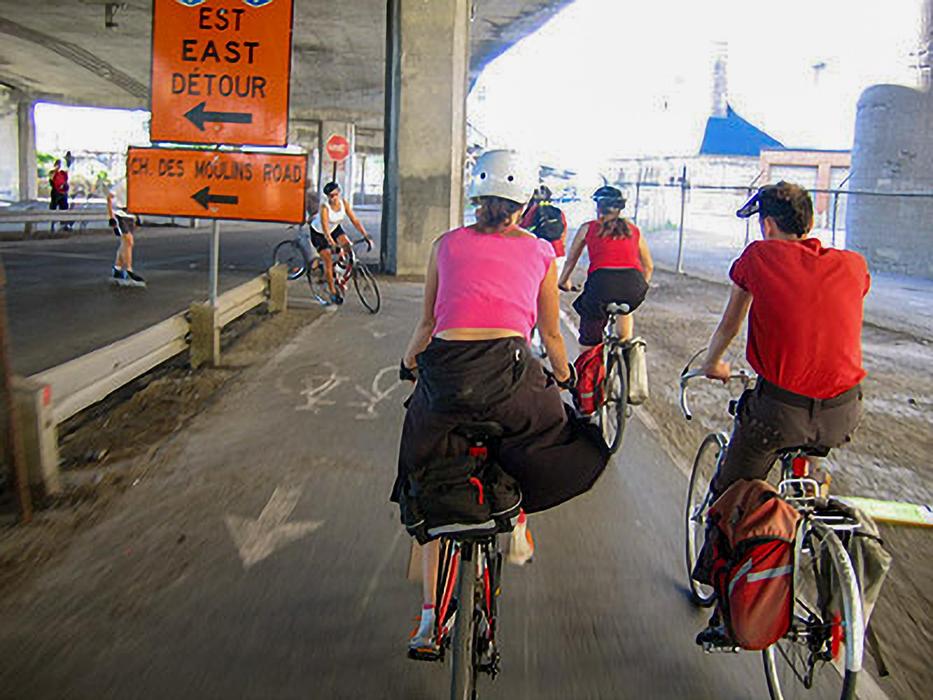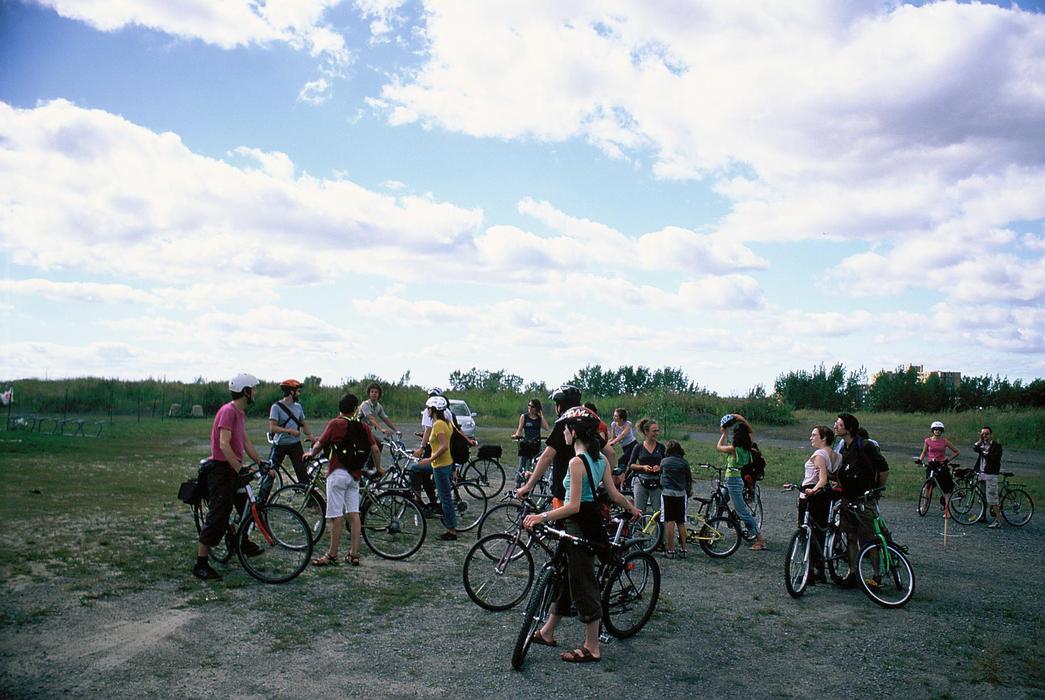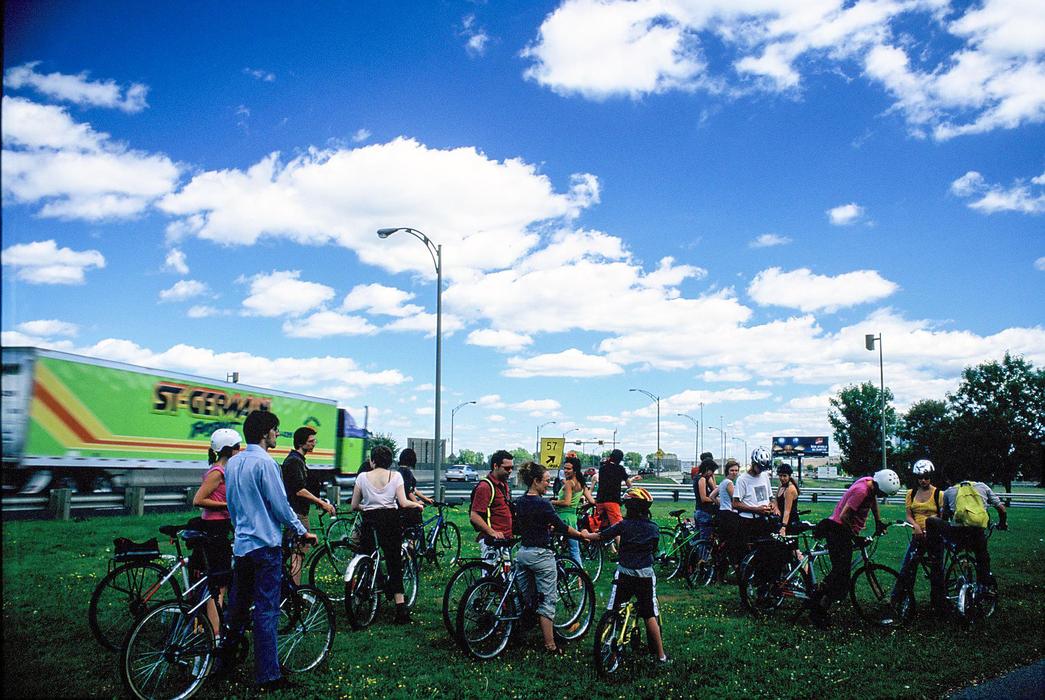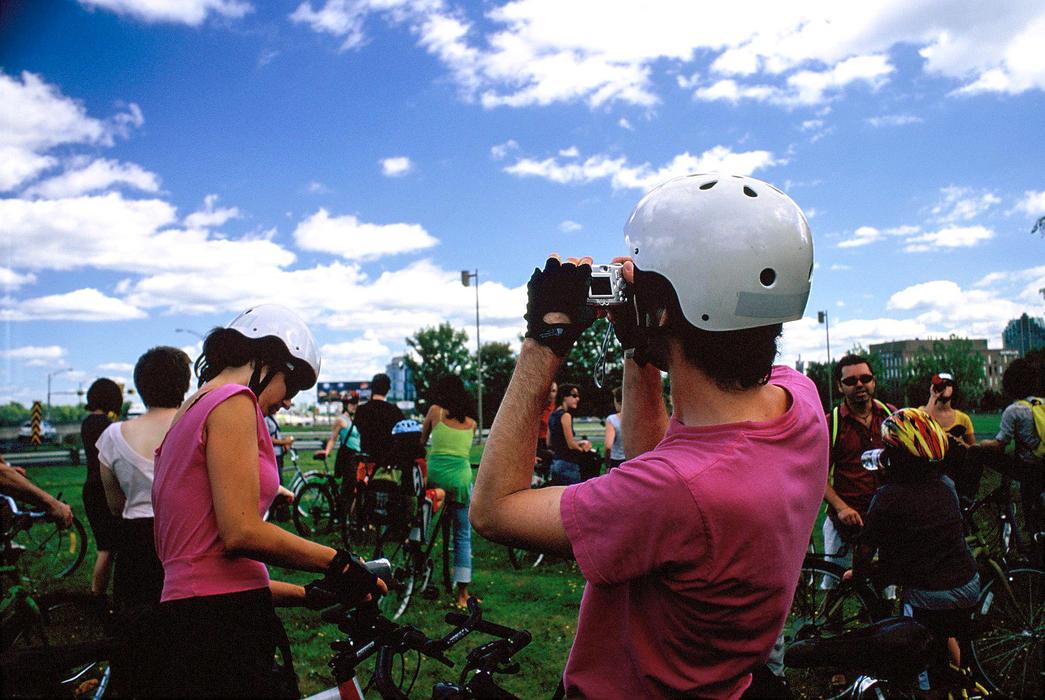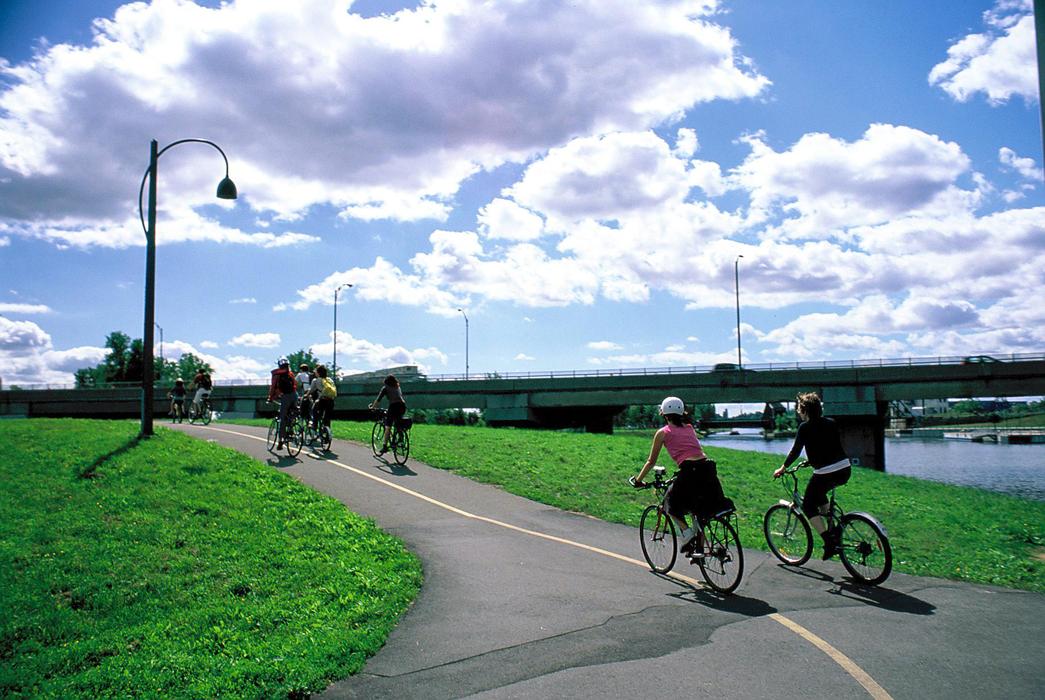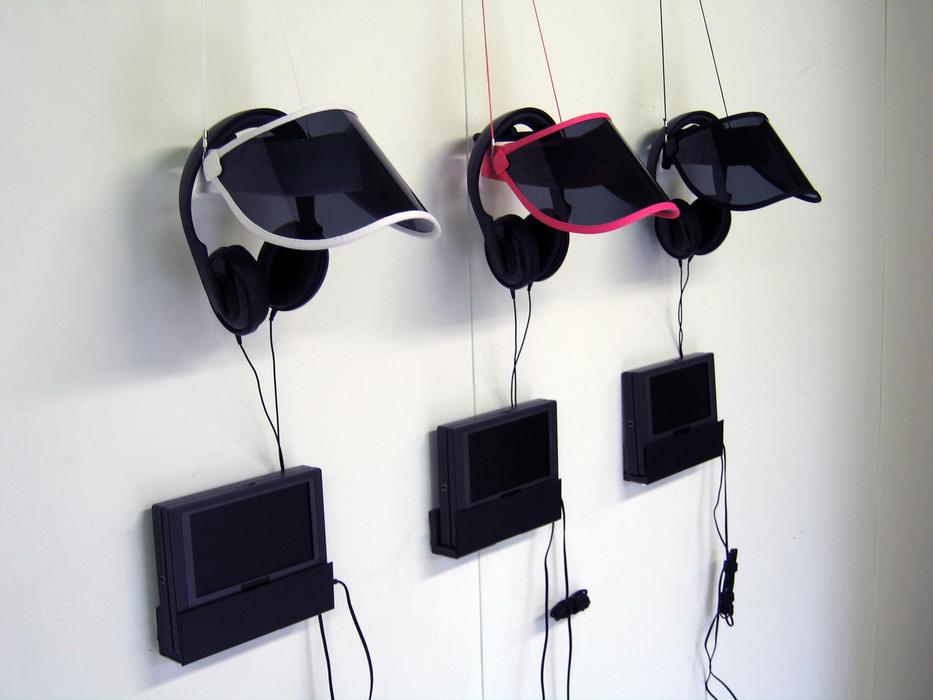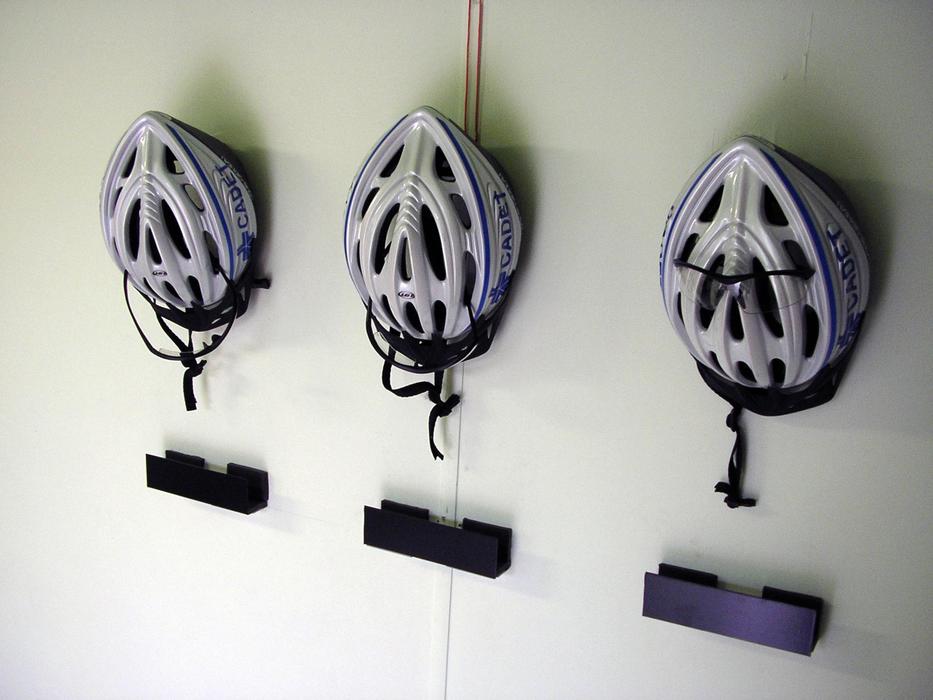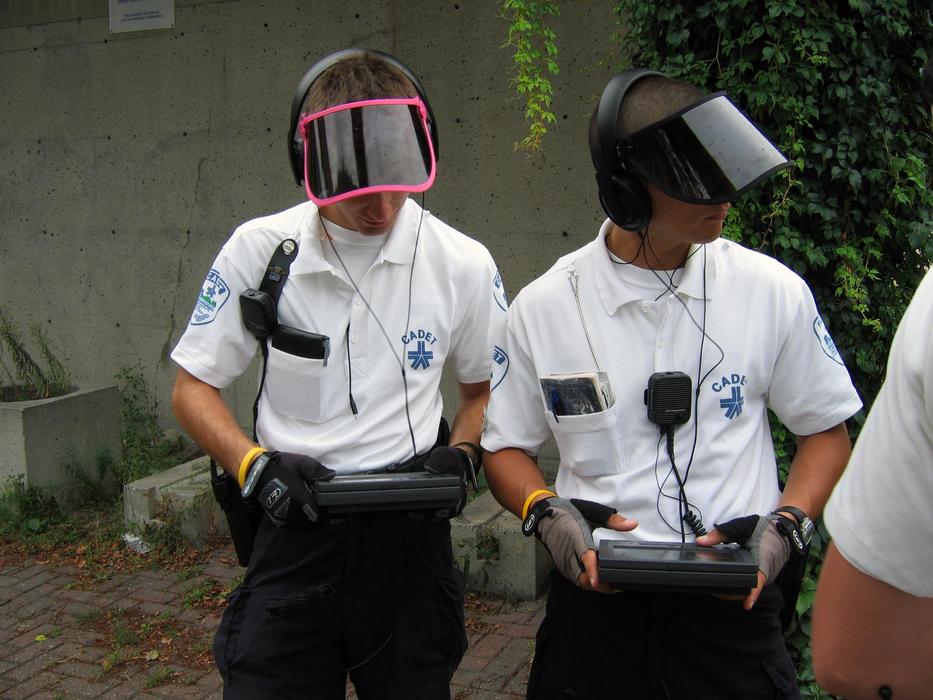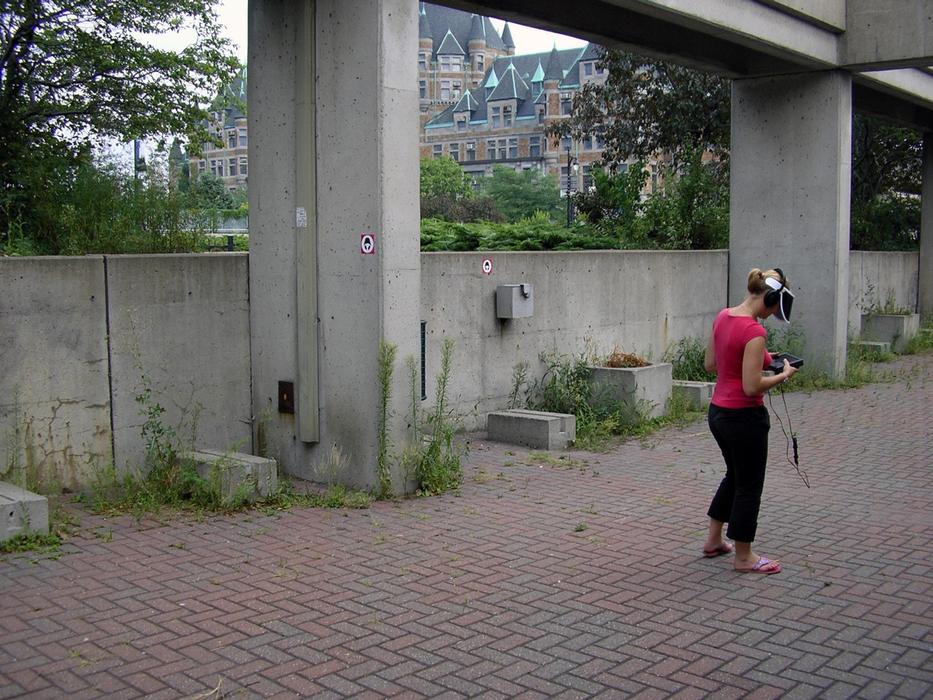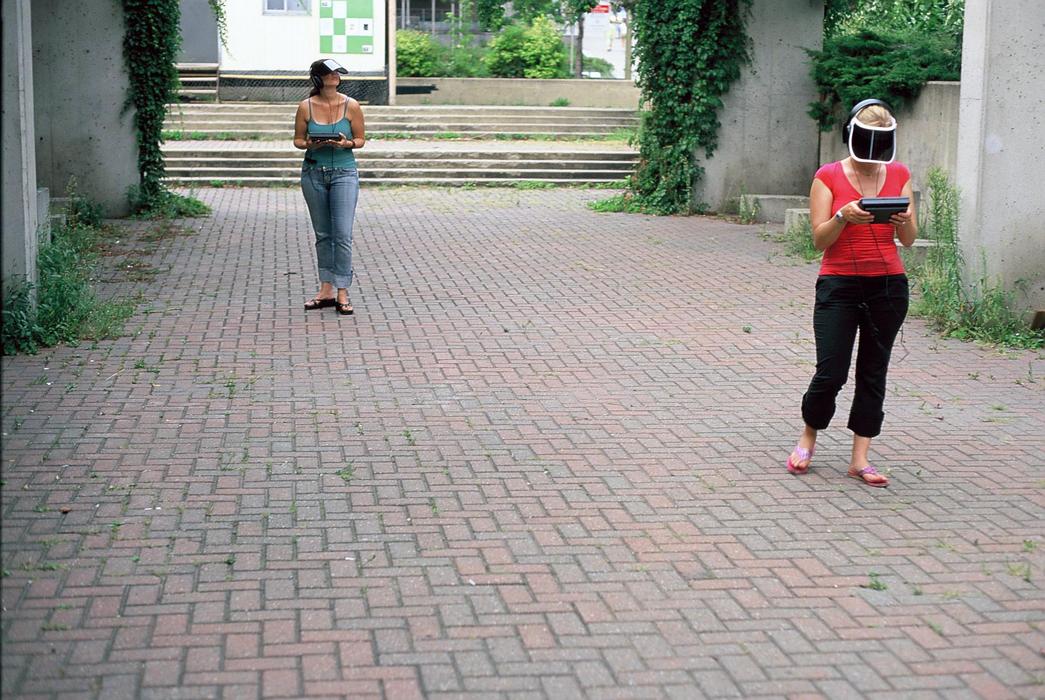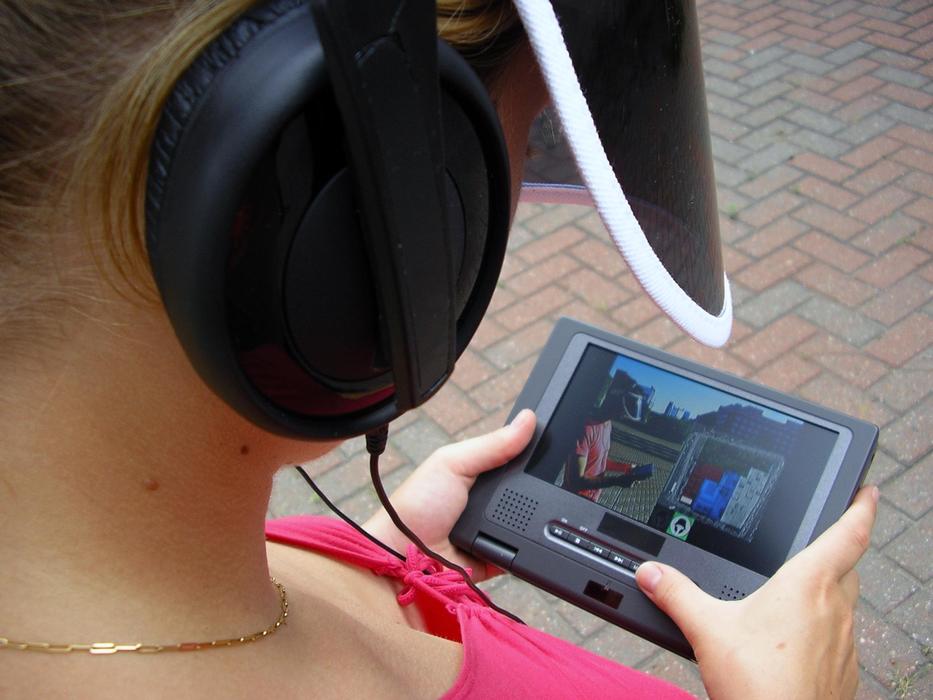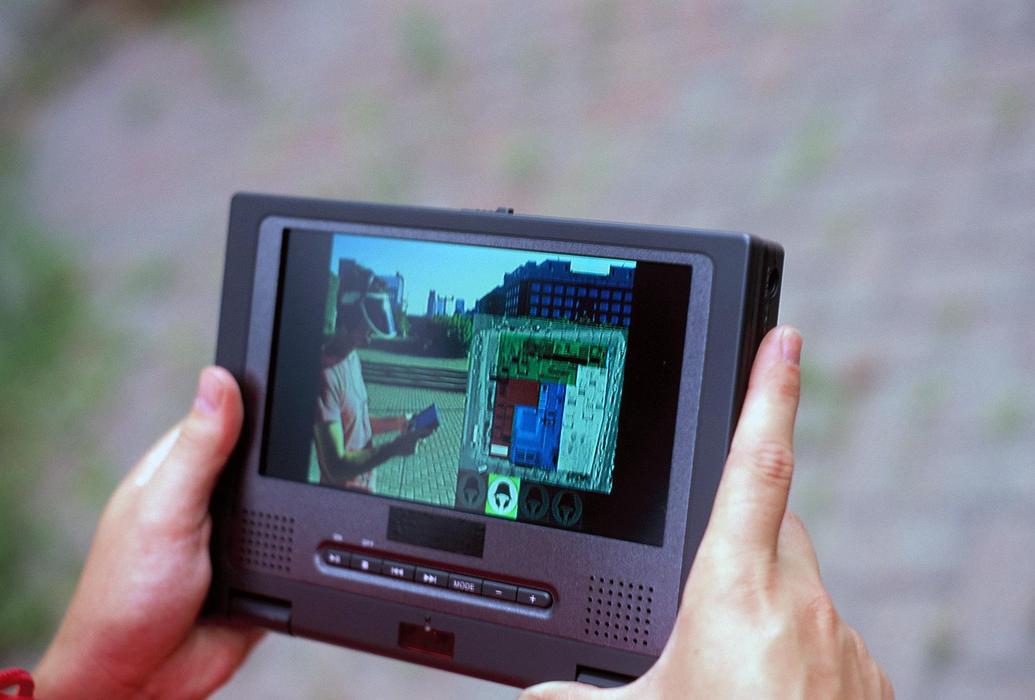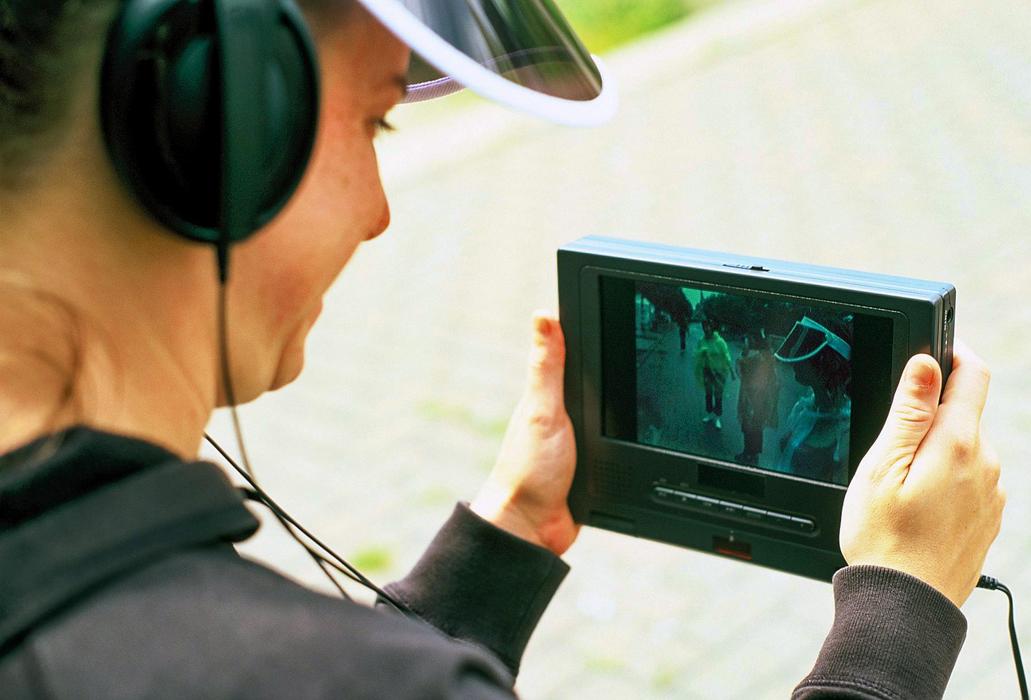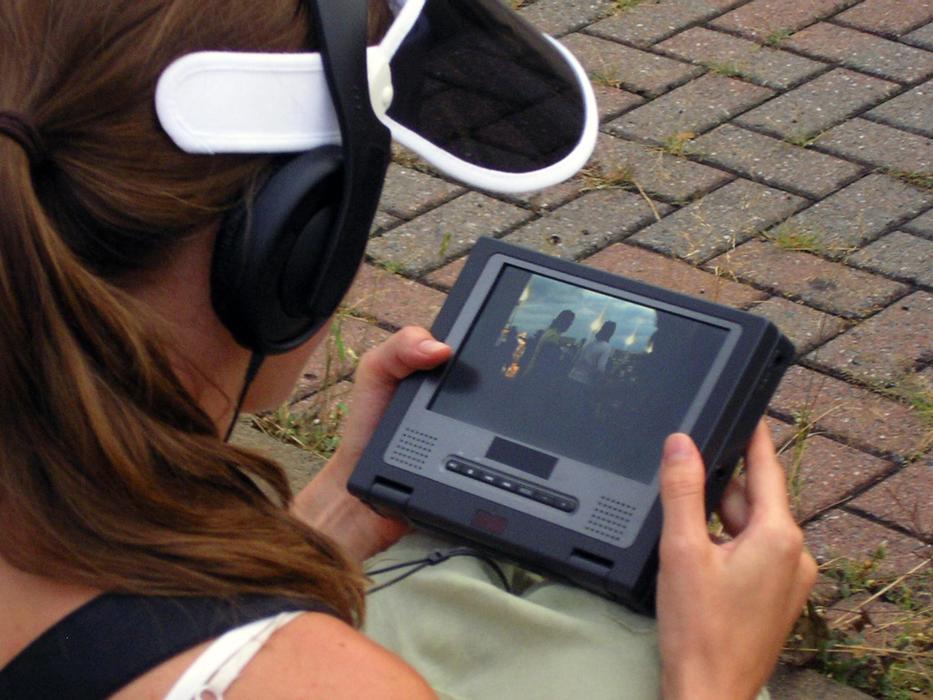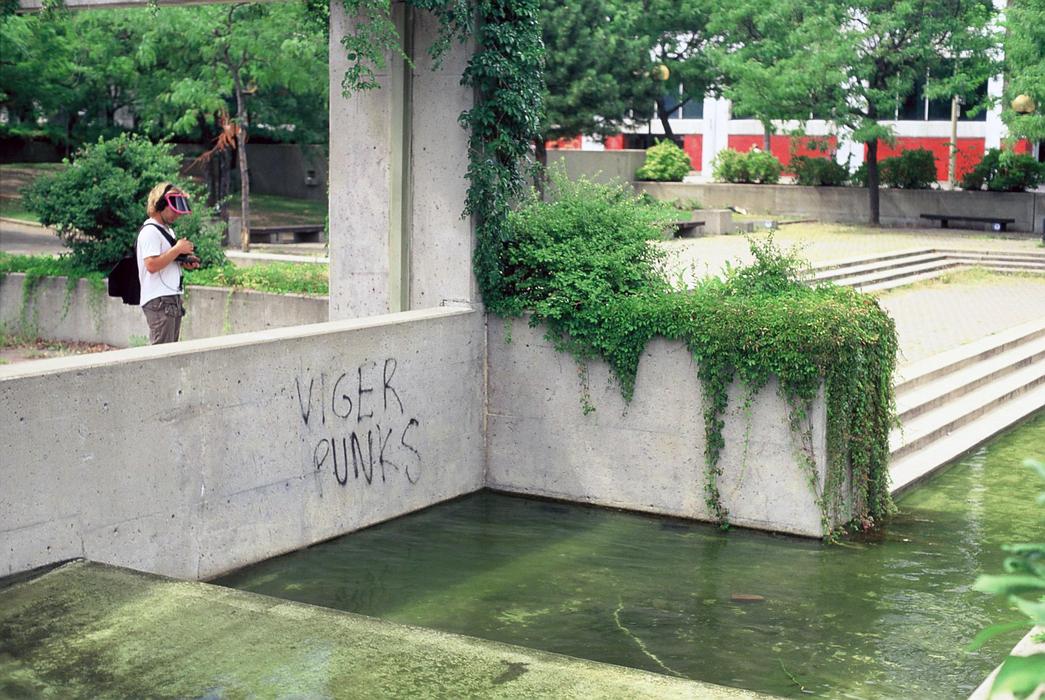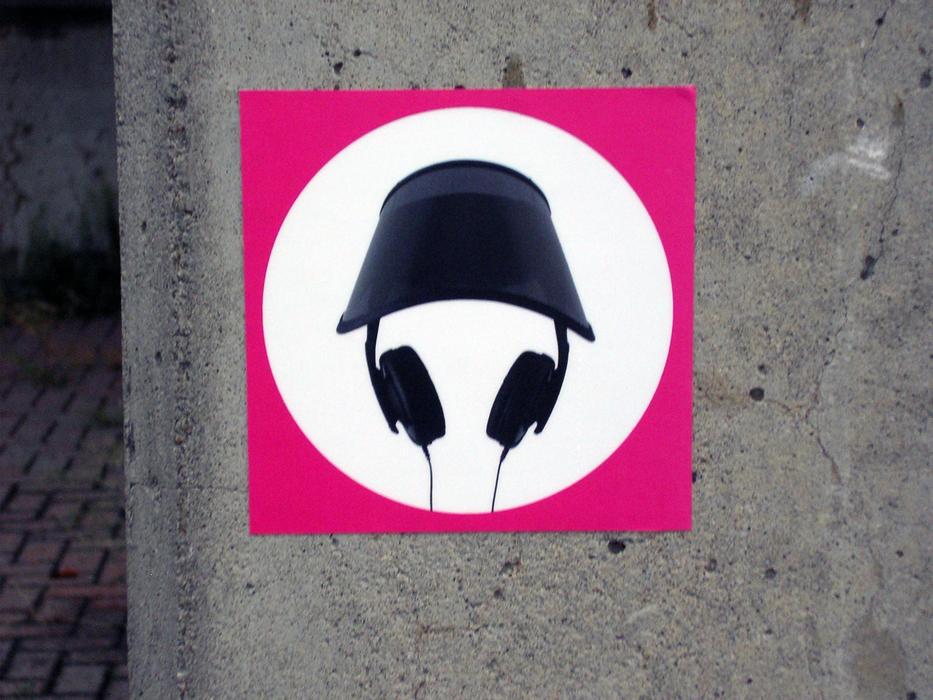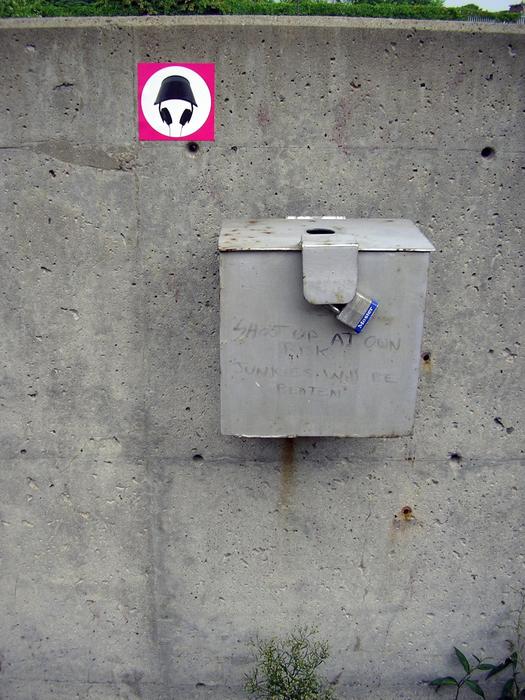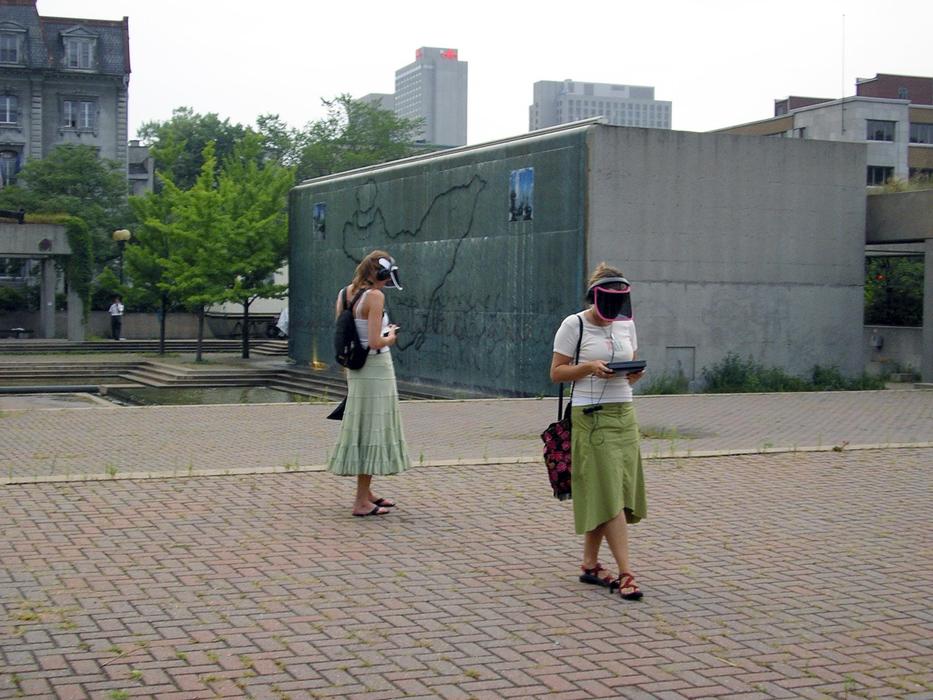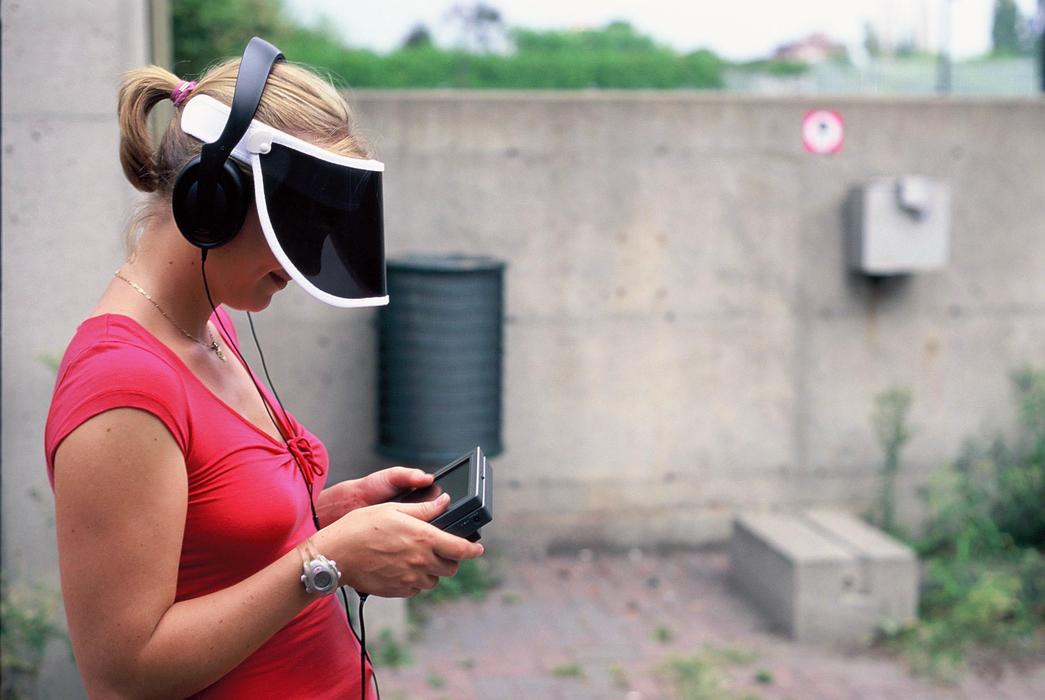Programming
Jean-Maxime Dufresne and Virginie Laganière
Hot Spots
During heat waves, the Hot Spots project focuses on the sphere of leisure and the transformations that its practice causes on urban space and social interactions.
View more
Excursions en vélo - Interventions vidéosonores
Excursions/interventions in the city in July and August
Opening on Wednesday, August 10 from 6pm to 10pm at Viger Square
Video walks at Viger Square from August 11 to September 9, 2005
The public is invited to a bike ride Sunday, September 4, 2005 at 13h, departure from Viger Square
During heat waves, the Hot Spots project focuses on the sphere of leisure and the transformations that its practice causes on urban space and social interactions. Combining the simple bike tour and the psychogeographic getaway, Dufresne and Laganière explore recreational areas defined both by the presence of recreational facilities and by more spontaneous occupations. In this way, artists question the attitudes and perceptions that are shaped there, on the freedom and the codification of the courses, on the phenomena of affluence or on landscape considerations. They also seek to invest places more affected by tourism and to identify other forms of representation.
Artists favor the use of bicycles both as a mobile vector of exploration and as an accessible means of urban travel. In this sense, Hot Spots is experimenting with the bicycle network of the island of Montreal by focusing on the glimpses that it allows on the urban territory. Biorhythmic cadences, sports maneuvers, extended stops, unusual events and experiences of otherness take turns along the path punctuated by fresh air and smog alerts.
Hot Spots evolves on a daily basis on the lookout for "hot" hot spots. The project is divided into three parts: day or night excursions made by the artists with two sensor-broadcaster bikes, video walks at Viger Square and a website powered by a continuous update.
IInterested by the possibilities of experiences offered by the city and its many conditions, Jean-Maxime Dufresne and Virginie Laganière regularly work on projects of a psycho-geographical nature. In particular, their intervention Surfaces de réparation was presented during Ravaudage urbain at AXENÉO7 in 2003. Both are involved in the organization of peripheral events.
The artists thank the Conseil des arts et des lettres du Québec for their support.
Jean-Maxime Dufresne (Montreal) holds a degree in architecture and is completing a Master's degree in Interactive Media at UQAM. His research focuses on the modalities of territorial experience in a practice that integrates a relationship to technological mediation, which has recently led him to present Rest Area (Interstices / Algorumthmes / UPH 10). He is a member of the urban exploration workshop SYN-, which has carried out a series of interventions in the city, including Hypothèses d’insertions (AXENÉO7) and Prospectus (CCA Extramuros). In 2006, he will exhibit his work at Optica.
Virginie Laganière (Montreal) is pursuing a Master's degree in Visual and Media Arts at UQAM. Promoting the mode of the journey within the urban space, her video and sound practice seeks to build new connections by meeting foreign places. Her work has been shown at events in electronic art organized by Champ Libre, Perte de signal, Daïmon et Mutek. Last spring, she took part in Télétaxi organized by the Year 01 collective as part of the DARE-DARE programming.
Activity report
The project ran from August 11 to September 9, 2005 in Viger Square and throughout the city of Montreal.
The public is invited to a bicycle drift on Sunday, September 4, 2005 at 1 p.m., departing from Square Viger.
The leisure landscape
Have all the maps been drawn? Some sociologists and philosophers are now talking of a saturation of space. They even evoke a turning point in spatial perception: the transition from extensive to intensive space, in which discovery is no longer a matter of spreading out, but of dividing up. Nonetheless, we remain stimulated by the possibility of an alter-native, and our conquering spirit - since it's a question of thinking about space - is always on the lookout for new territories. As for him, the Hot spots project isn't about discovery; it's more about redefining and updating a practical way of thinking that leads to new forms of inhabitation-occupation of the city-space.
Jean-Maxime Dufresne and Virginie Laganière target leisure spaces where social interactions are initiated. At first glance, the artists invest the space and observe the practice that emerges. The intention is to play, but the position of observation quickly shifts to "a practice that invents itself in practice.1" What we retain mainly from these interactions are practices (now plural) and readings on the dense text of leisure2. On the one hand, more or less structured walks in the city and its margins, where organized activities prescribe access and possibilities. On the other, the organization of an activity, a mediated walk in the square. And finally, to gather all this together, without pausing for a moment, an archiving and broadcasting site on the Internet where viewers can see even more, thus multiplying their own experience tenfold.
Hot spots is about the relationship between the cycle and the city, and more specifically, an exploration of the possibilities offered by cycling in the city. So, when we talk about permissions, we're interested in the transformation of space by a practice. This interest underpins a certain fixed conception of leisure space, as if to emphasize that the circuit is a closed form. What emerges are routes determined by the mode of travel itself; the greater territory has been invested through networks of circulation. It can't be said that the route is already mapped out, as cycle paths3 always impose choices by means of connectors. It is from this conception of the city as a space of circulation that it has been possible to rethink space in terms of a practice of places, a linking of places and non-places. In this way, Dufresne and Laganière considered both interstices and interfaces; they considered the non-fixity of places, spacing, what Benoît Goetz 4 calls "dislocation".
Moreover, this intervention in the city relies on technological devices (digital cameras and monitors) that help to recover a certain extension of space. By instrumentalizing the walk with audiovisual sensors/players, they have created a loop [reception-perception-processing-diffusion] that establishes overlaps and phase shifts in the perception of the walk. In the light of what we are given to see, it becomes possible to reverse this loop. While this intervention focuses on the modalities of perception, it also returns to the heart of leisure, reminding us that it is also a question of evaluation and permission. It is no longer possible to dissociate entertainment and freedom of practice. Leisure in the city is a political moment in the occupation of space. From the practice of a leisure activity emerge a technique, a know-how, an art. Cycling is all about knowing and planning your routes. Pedaling well. Indicate your destination. Read and follow directions. Better still: transgress them. There are all sorts of instruments to accompany the ride: maps, helmets, shoes, bags and other objects that click. A series of codes are designed to regulate uses and users, responding to demand, environment, ideology and even politics. In a similar vein, it's reasonable to think that, from this link between leisure and art, there's also a practice that links leisure to the city. We assume that this gives rise to an art of the city.
All things considered, the Hot Spots project remains a project of journeys and recourse where nothing is fixed, and which thus responds to the nature of the spaces frequented. The leisure spots will have been places of experimentation, permissive, out of bounds. Hot spots are about the importance of going outside in summer and getting out there, "because there's always something to see", and in the interval, changing places, feeling the tension and sprawl of the square. Posting oneself on the square will remain a consideration of action, but a project like Dufresne and Laganière's reactivates an opening, that of the resonance of seeing in the post, i.e. it brings perspective back to the fore in positioning. Once again, leisure can only be entertainment.
Mathieu Fraser-Dagenais, October 2005
1. CAUQUELIN, Anne, Cinévilles, Union Générale d'Éditions, 10/18, 1979, p.299.
2. As Michel de Certeau puts it in L'invention du quotidien, the place is a text (or image), a fabric where "the law of the proper reigns", while space would be multiple and practical, and would therefore be a reading.
3. Adapted and reserved exclusively or not for cyclists.
4. GOETZ, Benoît, La dislocation, architecture et philosophie, Les éditions de la passion, Paris, 2001, p.192
